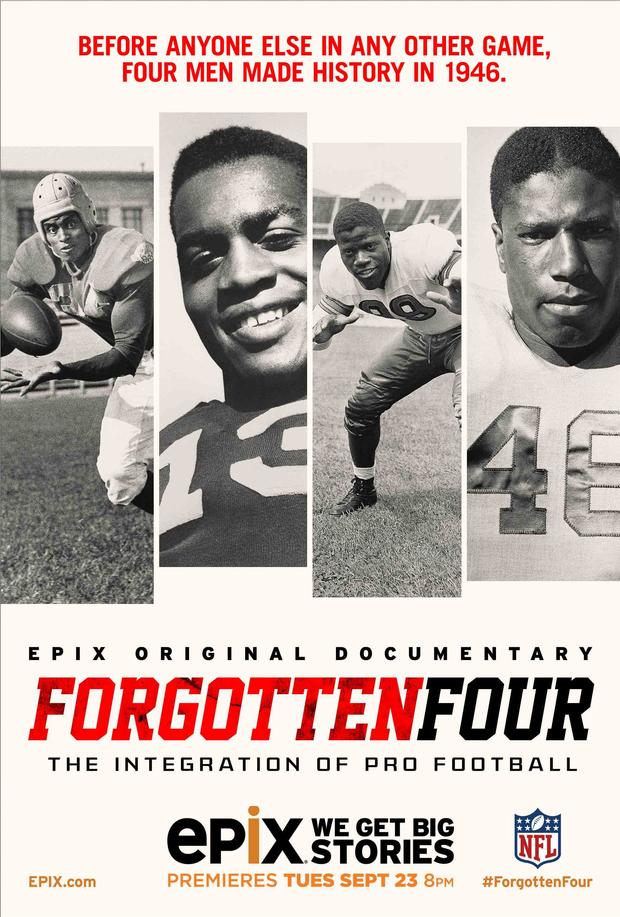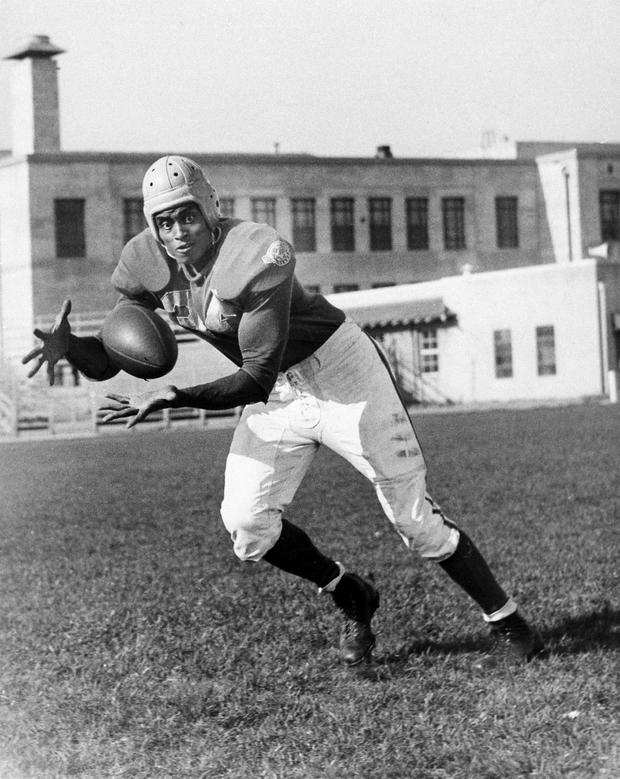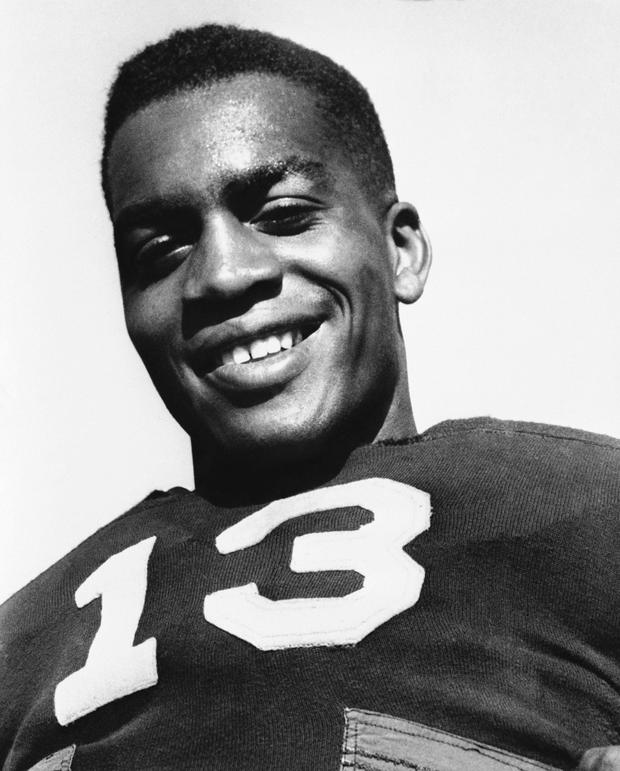Schwartz: Forgotten No More — The Story Of Football's Trailblazers
By Peter Schwartz
» More Columns
The story of Jackie Robinson breaking baseball's color barrier in 1947 has been well-documented over the years. In fact, new generations of baseball fans here in the New York area have learned about the pioneer simply by walking through the Jackie Robinson Rotunda at Citi Field.
But what many people don't know is that there was an integration of another sort that took place just one year earlier, and that was in professional football.
Four courageous men -- Marion Motley, Woody Strode, Kenny Washington and Bill Willis -- broke the color barrier in pro football, and their story is "Forgotten Four: The Integration of Pro Football," an original documentary from Epix that will premiere on Tuesday, September 23 at 8 p.m.
It's an outstanding film that every football fan needs to watch.
"I think it's about time that those four men were recognized for their courageous battle that they waged in order to integrate professional football," said executive producer Ross Greenburg, formerly of HBO Sports. "The fact that they did it in 1946, the year before Jackie, is an astounding development. And frankly, I was so shocked when I first learned of it that I knew that a documentary had to be made."
Pro football in the United States had actually been integrated somewhat from 1904 to 1933, with 17 African Americans playing in the NFL. But after the Great Depression hit the country in 1929, things began to change. At the 1933 NFL owners meetings, it's believed that Washington Redskins Owner George Preston Marshall -- a documented bigot -- convinced the other owners to no longer permit African Americans to play.
A "gentleman's agreement" was formed and professional football was segregated.
"I think that the American public is going to be caught off-guard that they never knew that this story even existed," said Greenburg.
The color lines existed until 1946 when Cleveland Browns owner Paul Brown signed Marion Motley and Bill Willis. Brown's team was in a new league called the All America Football Conference, but it was a move that changed the landscape of pro football.
"Paul Brown did every bit as much for racial integration as (former Dodgers general manager) Branch Rickey, and he's never ever gotten that credit," said Greenburg.
Until now, that is, when the story is told about how Brown did for football what Rickey did for baseball.
THE FORGOTTEN FOUR
Marion Motley
Motley was born on June 5, 1920 in Leesburg, Georgia. He grew up in Canton, Ohio, where he attended Canton McKinley High School and played both football and basketball. Particularly effective as a fullback, he helped his school achieve a 25-3 record during his time there. The three losses were against one of the school's biggest rivals -- Massilon Washington High School -- led by coach Paul Brown.
"He was just a man among boys," said Tony Motley, Marion Motley's grandson. "He wasn't going to run from you; he was going to run at you, and it was going to take a couple of people to stop him."
After a brief stint at South Carolina State College -- and from there transferring to the University of Nevada, Reno -- where he starred on the football field from 1941-1943 -- he returned to Canton after suffering a serious knee injury. Marion joined the United States Navy in 1944 and was based at the Great Lakes Naval Training Station. There he played for the Great Lakes Blue Jackets, a military team coached by his former adversary, Paul Brown.
After the war, Brown became coach of the Cleveland Browns in the new All-America Football Conference and invited Motley to try out. Then working in a steel mill with plans to return to Reno to receive his degree, Motley changed direction, made the team and took his rightful place on the field.
Woody Strode
Strode was born on July 25, 1914 in Los Angeles, California, where he attended UCLA. During college, he was a world-class decathlon athlete as well as a talented football player. Woody, along with Washington and Robinson -- who became the first African American player in Major League Baseball in 1947 -- made up three of the four backfield players.
"My dad was the kind of man that every man wants to be," said Kalai Strode, Woody Strode's son. "The men loved him because he was rugged, he was tough. Women loved him because he was graceful, he was courteous and he had a great physicality."
After his time in college, Strode had brief stints in professional wrestling and in film acting as a way to support himself. In 1946, he was given an opportunity to play professional football for the Los Angeles Rams alongside his UCLA teammate, Washington. He only played for one year before deciding to play Canadian football for the Calgary Stampeders. He left the field of sports in 1949 due to injury, and went on to a successful acting career in Hollywood.
Kenny Washington
Washington was born on August 31, 1918 in Los Angeles, California. He grew up in an area known as Lincoln Heights, starred as a running back at Abraham Lincoln High School and attended UCLA along with Strode and Robinson. At the time, there were only a dozen black players in all of college football, and UCLA had four of them. Washington helped guide the 1939 UCLA Bruins to a championship, leading the nation in total offense in the process.
"Everybody knew him," said Karin L. Cohen, Kenny Washington's daughter. "I knew he wasn't the mayor, I knew he wasn't the king; but everybody treated him like that, so I kind of thought he ran things."
Washington became the first consensus All-American in the history of the school's program, but was omitted from the East-West Shrine Game, an action many attributed to racial prejudice. Washington played for the Hollywood Bears in the Pacific Coast Professional Football League from 1941-1945. In 1946, the Los Angeles Rams signed him and fellow UCLA teammate Strode to play in the NFL. The impact he had on the league was enormous, as he immediately became a bona fide star.
Bill Willis
Willis was born on October 5, 1921 in Columbus, Ohio. He attended Columbus East High School, where he participated in track and field and played on the football team. After graduating from high school, Willis enrolled at Ohio State University in 1941 and played under coach Paul Brown. Willis played middle guard, helping the Buckeyes post a 9-1 record and leading them to a Big Ten Conference title and a national championship. Before the following season, Willis -- along with other players -- enlisted in the U.S Army, but he was classified as 4-F due to varicose veins.
"I can't think of anybody who has been so inspirational in terms of how to carry yourself, how to try and do the very best in every situation, than my dad," said William Willis, Jr., son of Bill Willis.
In 1944, Willis was named to the United Press International and Look Magazine All-America Teams. He played in the 1944 College All-Star game against the Chicago Bears and was named the game's outstanding player. With a desire to still play football after college, he called coach Brown, who at that point was a coach with the Cleveland Browns. He was invited to try out, made the team alongside Motley and was integral to the reintegration of professional football.
____________________________________________________________________________________
The documentary goes into detail about how integration came to the NFL and how Brown played a role in that. When he started the Cleveland Browns, the Cleveland Rams moved to Los Angeles and wanted to play at the Los Angeles Coliseum.
But since the Coliseum was a public facility, there was pressure to not allow the Rams to play there unless they allowed African-Americans to play for them. So after Motley and Willis joined the Browns, Kenny Washington and Woody Strode became NFL pioneers by joining the Rams.
The NFL has embraced the documentary and has partnered with Epix in arranging local screenings around the country that are followed by panel discussions on the current state of race relations and athletics.
"I called (NFL Commissioner) Roger Goodell very early and I told him what I wanted to do, and he wrapped his arms around it," said Greenburg.
Some of the teams taking part in the screenings/panel discussions include the Buffalo Bills, Dallas Cowboys, Green Bay Packers, Miami Dolphins and Washington Redskins.
But this documentary is about more than just football. It's about telling the story of what was going on in our country at that time, and the film does so with some very strong photos and footage documenting the racism and segregation that was taking place.
"My whole plan in telling the story was to give people a sweeping understanding and history of the racial divide in American culture over the last 100 years," said Greenburg. "I do think that some of the photos and footage are a little striking and difficult to see, but it was important because I think we need to be honest with who we were as a culture."
This is a very powerful and informative documentary. It's the story of four courageous men who fought racism on and off the field and paved the way for future generations.
Don't forget to follow me on Twitter @pschwartzcbsfan. You can also follow Epix @EpixHD and use the hashtag #ForgottenFour.
You May Also Be Interested In These Stories








